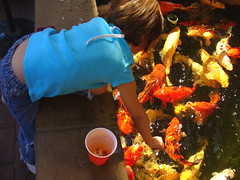 As the father of two young children I spend lots of time watching them learn and play. I have noticed that when they are having fun they are most receptive to new ideas. Every night as I read to them I know that they are soaking up knowledge, without much effort. Wouldn't it be good if all learning was like that?
As the father of two young children I spend lots of time watching them learn and play. I have noticed that when they are having fun they are most receptive to new ideas. Every night as I read to them I know that they are soaking up knowledge, without much effort. Wouldn't it be good if all learning was like that?For most learners it's not, and learning a second language is hard work. When you are starting out there is a lot to remember. For many people we have the benefit of time, and repetition, where techniques like spaced repetition can really work their magic.
But what if you don't have a lot of time? If you have used something like ANKI or supermemo before you'll know how quickly things get out of hand if you try to schedule too many repetitions in a short time frame.
Language learning techniques are all Greek to me
This is where a mnemonics comes into play. Mnemonics may sound like quackery, up there with hypnosis and ouija boards, but it has a long and illustrious history that started with Greek orators memorising long speeches before the senate. Now you may not need to memorise Homer's Odyssey in a hurry, but it might help to know a few key phrases before you head of to Japan in less than a fortnight.
 Some people recommend using crazy visualisation with mnemonic techniques for vocabulary. It seems to me more hard work than it's worth, particularly when every thing about a new language is crazy and abstract when you are learning it for the first time. Abstraction is akin to falling in love with carp, unnecessarily complicated and unnatural.
Some people recommend using crazy visualisation with mnemonic techniques for vocabulary. It seems to me more hard work than it's worth, particularly when every thing about a new language is crazy and abstract when you are learning it for the first time. Abstraction is akin to falling in love with carp, unnecessarily complicated and unnatural.There are several methods used in mnemonics, including the original ancient greek method of loci, and even some with a distinctly Japanese flavour. The method I'd like to focus on today is the memory peg system.
Mnemonic approaches to learning Japanese
Japanese has it's own natural "pegs" to hang memory on, called gojuuon (fifty sounds). And while you can use sentences in English like "A Kindergarten School Teacher Never Has Much Yen. Recreation WastelaNd!" to remember the dictionary order of words, wouldn't it make more sense to take a native approach?
The Japanese have been doing this since the Heian period (AD 794–1179), when the Buddhist poem "Iroha" (いろは)was written as way to order the syllabary. The Iroha is still used today as way to order seats in theatres. These days the gojūon (五十音, literally "fifty sounds") is more common as a way to order things. Conveniently enough, it's also found on Japanese cell phones (けいたい).
This means it's really easy to pick up, because it's repeated everywhere! All you have to do is hang something on those pegs that is kind of memorable, like a children’s story, and then keep building from there.
Here's something I prepared a little earlier for my class. A reading of the children's classic "Guri and Gura's A I U E O" (ぐりとぐらのあいうえお) text by Rieko Nakagawa and illustrations by Yuriko Yamawaki, published by Fukuinkan Shoten.
If you would like to learn more about this works in practice, please join me for the free class on eduFire, Field Mice and Japanese Mnemonics or ask me about it on twitter.
Do you use mnemonic devices when you study Japanese? What other memory aiding tricks have you developed?


